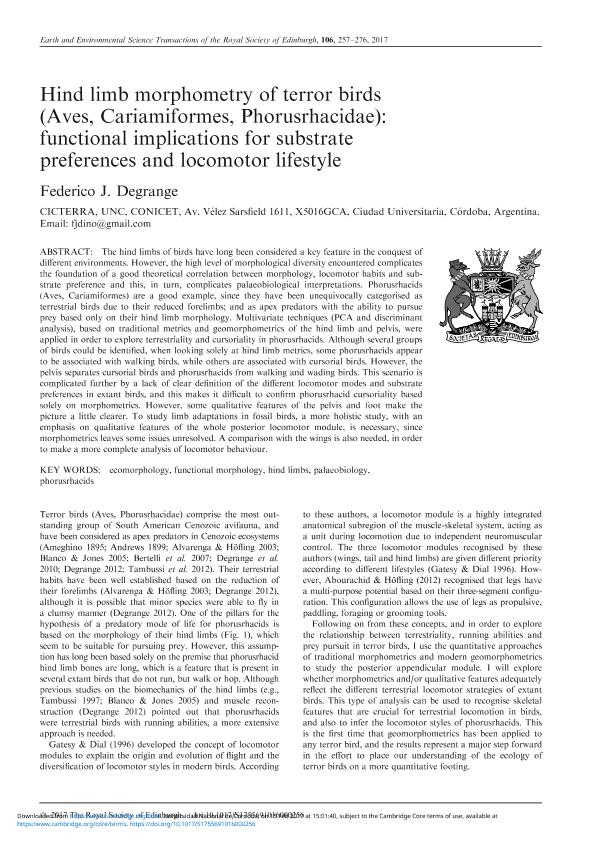Mostrar el registro sencillo del ítem
dc.contributor.author
Degrange, Federico Javier

dc.date.available
2018-05-10T13:41:23Z
dc.date.issued
2017-02
dc.identifier.citation
Degrange, Federico Javier; Hind limb morphometry of terror birds (Aves, Cariamiformes, Phorusrhacidae): Functional implications for substrate preferences and locomotor lifestyle; Royal Society of Edinburgh; Earth and Environmental Science Transactions of the Royal Society of Edinburgh; 106; 4; 2-2017; 257-276
dc.identifier.issn
1755-6910
dc.identifier.uri
http://hdl.handle.net/11336/44728
dc.description.abstract
The hind limbs of birds have long been considered a key feature in the conquest of different environments. However, the high level of morphological diversity encountered complicates the foundation of a good theoretical correlation between morphology, locomotor habits and substrate preference and this, in turn, complicates palaeobiological interpretations. Phorusrhacids (Aves, Cariamiformes) are a good example, since they have been unequivocally categorised as terrestrial birds due to their reduced forelimbs; and as apex predators with the ability to pursue prey based only on their hind limb morphology. Multivariate techniques (PCA and discriminant analysis), based on traditional metrics and geomorphometrics of the hind limb and pelvis, were applied in order to explore terrestriality and cursoriality in phorusrhacids. Although several groups of birds could be identified, when looking solely at hind limb metrics, some phorusrhacids appear to be associated with walking birds, while others are associated with cursorial birds. However, the pelvis separates cursorial birds and phorusrhacids from walking and wading birds. This scenario is complicated further by a lack of clear definition of the different locomotor modes and substrate preferences in extant birds, and this makes it difficult to confirm phorusrhacid cursoriality based solely on morphometrics. However, some qualitative features of the pelvis and foot make the picture a little clearer. To study limb adaptations in fossil birds, a more holistic study, with an emphasis on qualitative features of the whole posterior locomotor module, is necessary, since morphometrics leaves some issues unresolved. A comparison with the wings is also needed, in order to make a more complete analysis of locomotor behaviour.
dc.format
application/pdf
dc.language.iso
eng
dc.publisher
Royal Society of Edinburgh

dc.rights
info:eu-repo/semantics/openAccess
dc.rights.uri
https://creativecommons.org/licenses/by-nc-sa/2.5/ar/
dc.subject
Ecomorphology
dc.subject
Functional Morphology
dc.subject
Hind Limbs
dc.subject
Palaeobiology
dc.subject
Phorusrhacids
dc.subject.classification
Meteorología y Ciencias Atmosféricas

dc.subject.classification
Ciencias de la Tierra y relacionadas con el Medio Ambiente

dc.subject.classification
CIENCIAS NATURALES Y EXACTAS

dc.title
Hind limb morphometry of terror birds (Aves, Cariamiformes, Phorusrhacidae): Functional implications for substrate preferences and locomotor lifestyle
dc.type
info:eu-repo/semantics/article
dc.type
info:ar-repo/semantics/artículo
dc.type
info:eu-repo/semantics/publishedVersion
dc.date.updated
2018-05-09T16:14:35Z
dc.journal.volume
106
dc.journal.number
4
dc.journal.pagination
257-276
dc.journal.pais
Reino Unido

dc.journal.ciudad
Edimburgo
dc.description.fil
Fil: Degrange, Federico Javier. Consejo Nacional de Investigaciones Científicas y Técnicas. Centro Científico Tecnológico Conicet - Córdoba. Centro de Investigaciones en Ciencias de la Tierra. Universidad Nacional de Córdoba. Facultad de Ciencias Exactas Físicas y Naturales. Centro de Investigaciones en Ciencias de la Tierra; Argentina
dc.journal.title
Earth and Environmental Science Transactions of the Royal Society of Edinburgh

dc.relation.alternativeid
info:eu-repo/semantics/altIdentifier/url/https://bit.ly/2I8UCJN
dc.relation.alternativeid
info:eu-repo/semantics/altIdentifier/doi/http://dx.doi.org/10.1017/S1755691016000256
Archivos asociados
